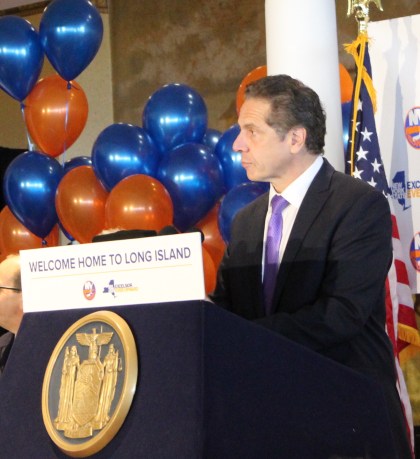Gov. Andrew Cuomo announced the LIRR will expand services at the Belmont station to operate all year round to accommodate for a new New York Islanders arena at Belmont Park.
The question on the public’s mind is how.
Cuomo mentioned the expanded services at a press conference last Wednesday when it was announced the Long Island hockey team would return to Nassau County.
The $1 billion project is scheduled to be finished by 2020.
Based on his 31 years working for the U.S. Department of Transportation Federal Transit Administration Larry Penner said he doesn’t think that’s a realistic timeline.
It could take three to five years of renovations to the station that would lead to off-peak service to Belmont, according to Penner.
Peak services, which would be necessary to get the public to evening events, could be an additional 11 to 13 years, according to Penner.
“The real challenge will be trying to provide full-time rush hour service in both directions,” Penner wrote in a letter to Blank Slate Media. “This may not be possible until 2032.”
Aaon Donovan, an LIRR spokesman, declined to comment on the timeframe but said the LIRR is “committed to improving service.”
Currently, the Belmont station is only used during the horse racing season. Even under those circumstances the station the station has faced issues in the past.
During the 2014 Belmont Stakes 36,000 people went to the station, resulting in overcrowding and wait times of over three hours, according to Newsday.
Following the incident, the LIRR invested $5 million to upgrade the station, Newsday reported.
The station will likely see large crowd sizes in the future, if the 18,000-seat arena is built as planned.
While it will be used in the hockey season as the Islanders home rink, the developers, Sterling Development and Oak View Group, have also stated the arena will be used for concerts and other events.
Additionally, the development will feature a retail center and hotel on site.
At this time, no specifics on how the LIRR plans to improve the station or accommodate for the extra trains have been released.
If the Belmont project is real, Penner said “someone ought to be able to share with the public in detail.”
There are other roadblocks to the proposed expanded services.
The plan follows other LIRR expansions proposed by Cuomo, including the MTA Main Line Third Track project. There are also plans for Amtrak and New Jersey Transit to expand.
Penner said there’s no master operating agreement for Penn Station as to which plan is going to get the space for their proposals.
“Right now, the LIRR is operating at 100 percent capacity,” Penner said.
Only one of the four East River tunnels can be worked on at a time, according to Penner. Three run inbound for the morning peak hours, and outbound for afternoon peak hours, Penner said. One is shared by the LIRR, NJ Transit and Amtrak for reverse train movements, he said.
If one tunnel is temporarily out of service it results in delays, Penner said.
Residents of surrounding areas, including Elmont and Floral Park, have been voicing concern with the proposed sports arena.
Some Elmont residents are even planning to take legal action, according to Aubrey Phillips, an Elmont resident and vice president of the Parkhurst Civic Association.
In a previous interview with Blank Slate Media Phillips said the Empire State Development Corp. broke with their own rules.
The development corporation is supposed to have a community advisory board, but no such group was put together to hear residents concerns, Phillips said.
Other residents are not pleased with the chosen project.
Tammie Williams, an Elmont resident and community organizer, previously told Blank Slate Media that a sports venue won’t benefit the community.
“They don’t bring sustainable jobs,” Williams said. “We do not pay our mortgages on selling hot dogs and beer.”
Penner said the residents are intelligent voters and taxpayers.
“If building sports arena is a good investment,” Penner said. “I’d say the investors can use their own money.”

